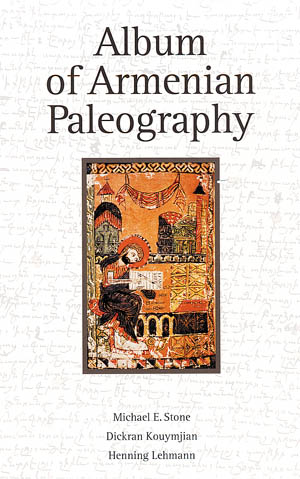Chris Tozlian
Staff Writer
An important contribution to Armenian studies, the Album of Armenian Paleography, was published by Aarhus University Press of Denmark in November 2002. The authors of this reference work, Professors Michael Stone, Henning Lehmann, and Dickran Kouymjian, spent twelve years on the production of the Album.

Dr. Dickran Kouymjian, Haig & Isabel Berberian Professor of Armenian Studies and the Director of the Armenian Studies Program at Fresno State, discussed, in an earlier Hye Sharzhoom interview, the meticulous work involved in completing the Album. During the last five years that the Album has been in press, it has undergone intensive editing, bibliographies required careful checking, and Armenian-to-English translations were checked for accuracy.
As the title indicates, the Album of Armenian Paleography focuses on how Armenian letters have changed form throughout a millennium, referencing two hundred accurately dated manuscripts, most of which came from the Matenadaran in Erevan, the Armenian Patriarchal Library in Jerusalem, and the Library of the Mekhitarist Fathers in San Lazzaro, Venice. The manuscripts were samples from among the 31,000 Armenian manuscripts preserved in collections throughout the world. The album includes manuscript samples dating from the ninth to the nineteenth centuries and also includes a small number of fifth to seventh century lapidary inscriptions and some nineteenth and twentieth century samples of handwriting of Armenian scholars and intellectuals.
Though other works have been produced on Armenian paleography, the Album of Armenian Paleography is the most comprehensive work to date. In fact, Professor Kouymjian presents all earlier major works and most earlier minor books and articles on Armenian paleography in his detailed history of Armenian paleography for the Album. Furthermore, great attention is given to detail, as professor Michael Stone comments on the change of each Armenian letter over time. Due to the in-depth nature of the Album, it will serve as a indispensable reference work for future scholars to research and comment on individual areas of Armenian paleography.

Unlike earlier works, the Album of Armenian Paleography has more than two hundred color plates of actual manuscripts, made available by computer technology and scanners. More impressive technologically, however, are the alphabet tables that accompany each manuscript picture.
In earlier works, these were artist reproductions made by hand to imitate the letters of the manuscript; however, for the first time, the authors used scanners to reproduce alphabet tables, using the actual letters from the manuscripts, not imitations.
This reference work will clearly impact the field of Armenian studies due to the massive research that it encompasses.As a result, future scholars will be able to make more definitive statements regarding Armenian paleography. Also, this work gives historians a clearer understanding of the chronology of Armenian manuscripts and will, by comparing characters, help scholars to date currently undated Armenian manuscripts. The album was produced in great detail and quality, which is clearly seen in its 556 pages, with more than two hundred color plates. This work will be of interest for all paleographers, codicologists, and students of Armenian culture.
The research and printing of the Album was supported by The Carlsberg Foundation of Copenhagen, with smaller grants from The Bertha and John Garabedian Charitable Foundation of Fresno, California, The Research Foundation of the Hebrew University of Jerusalem, The National Endowment for the Humanities, and a Technology Research Grant, California State University, Fresno.
 Hye Sharzhoom Armenian Action
Hye Sharzhoom Armenian Action